Les Noces (1914–23)
When Stravinsky himself first drew attention to the coincidence of meter and phrase in certain passages of irregular barring in The Rite (recalling that in many such instances he had sought "to measure according to phrasing"), he had in mind rather specifically the lengthy, irregular measures of the early sketchbook and printed versions of "Evocation of the Ancestors" and "Sacrificial Dance." Clearly, however, the logic of this coincidence extends to the later application of "smaller divisions" as well. Nor is the progression from large to small confined to the composition and revision of The Rite . An early draft of Les Noces , scored for mezzo soprano, woodwinds, and double string quintet, exhibits the same symptoms in relation to this work's final version of 1917–23.[34]
Labeled A and B, the opening two blocks of Les Noces are reproduced in Examples 19 and 20; Example 19 is from the draft (where the two blocks are set apart by a change in tempo), and Example 20 is condensed from the final version. The earlier version features longer measures of seven, six, and five eighth-note beats that were subsequently sliced up into "smaller divisions" of two and three beats. Nor does the correspondence end here, for the proportions in these two versions of Les Noces are quite different. Just as with the several versions of the "Evocation" examined in Chapter 2, the opening material of Les Noces underwent a process of expansion: Block A is considerably
[34] This early Noces draft is now a part of the Paul Sacher Foundation in Basel, Switzerland. A facsimile of the first page appears in Vera Stravinsky and Robert Craft, Stravinsky in Pictures and Documents (New York: Simon and Schuster, 1978), p. 144.
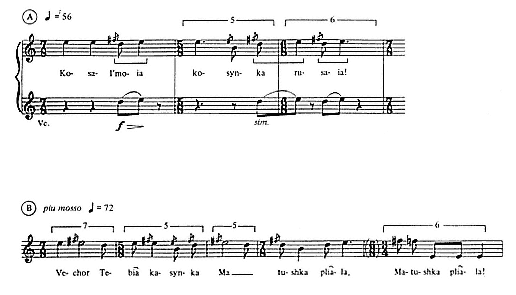
Example 19:
Les Noces (early draft)
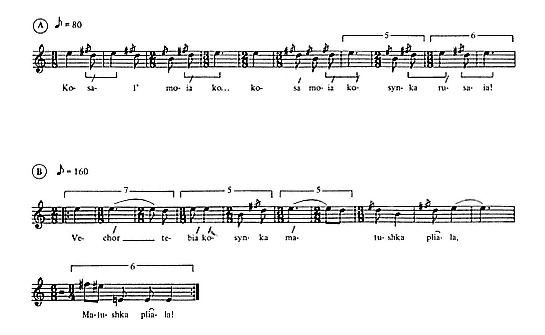
Example 20:
Les Noces
shorter in the earlier version, while Block B, although very nearly intact, misses the final arrangement by a quarter-note beat. The brackets in Examples 19 and 20 mark off the longer measures of the earlier sketch which, in subdivisions, were retained by the final version.
More critical distinctions between these two Noces texts relate to motivic identity, pulse, and tempo. Notice that the two




Some of these implications are detailed in Example 21, where the two versions of Block A are placed in vertical alignment. The retained






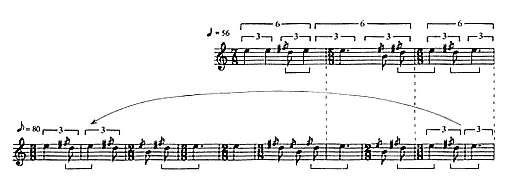
Example 21:
Les Noces
More eventful from the standpoint of fixed metric identity is the tiny D-E segment. Marked off by brackets underneath both versions of Block A in Example 21, D-E is a part of E-D-E and of subsequent extensions of this motive as well. Returns to E invariably come by way of D, and the succession is stressed by a doubling in the cello in the early draft (see Example 19) and by octave doublings in Pianos I and III in the final version (see Example 23). Notice, however, that in accord with the longer measures of the early draft, D-E is barred differently on each occasion, while, in the finished score, D-E is always barred as an over-the-barline succession; irrespective of the notated irregularity, D-E assumes the same metric identity. Hence, just as with the E-D-E motive, the finished score latches on to a fixed element or constancy, here in the form of the smaller but more pervasive D-E component. In addition, E, as the registrally fixed pitch of departure and return, always falls on the first beats of the irregular measures. Indeed, as can now readily be seen, the notated irregularity of the final arrangement is in large part determined by these metrically fixed components; they tend, as it were, to regulate the irregularity . The shifting meter seeks, at least in part, to preserve fixed identity in repetition.
A summary of these conclusions appears in Example 22, where a hypothetical scheme further demonstrates just how regular the irregularity is. Observe how the shifting meter revolves around the fixed components, and in particular the over-the-barline identity of D-E. Indeed, according to the hypothesized version, Block A contains only three motivically defined metrical units: a



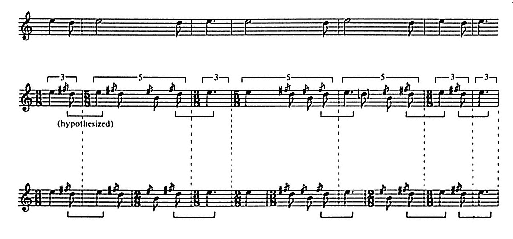
Example 22:
Les Noces
bar for E-D-B-D. And if we omit the dotted quarter-note, the scheme reduces to only two such units: E-D-(E) and an extension in the form of E-D-B-D-(E). (In the fifth bar of the hypothetical version, the dot of the quarter-note must yield to D as an eighth-note [marked by parentheses] to allow for complete motivic correlation.) So, too, there are only







Notice, too, that the natural stresses of the Russian syllables underscore D-E as a metrically fixed unit in the final version.[35] As is shown by the stress markings for Block A in Example 20, these stresses coincide with the (musically) stressed D of the D-E unit for all D-E repeats except the final two. In contrast, the repeats of D-E in the draft (Example 19), although doubled by a solo cello, lack this support. In view of the tradition of flexible accentuation in the singing of Russian popular verse, the coincidence here of natural stress and musical accent (for the upbeat D of the D-E unit) takes on an obvious significance.[36] A peculiarly Stravinskian trait in these opening passages is the stutter effect, the repeat, in the fourth and fifth measures of the final version, of the individual syllable ko of Kosal ', meaning "braid." Within the framework of a bride's ritualized lament, the stutter suggests a sob or sigh.
Up to this point the logic of the barring has been pursued solely from the standpoint of metrically fixed elements. What may be termed the opposite
[35] A translation of the two lines of Blocks A and B runs as follows: "Braid, my dear little blond braid!/Yesterday my mother braided you, my dear little braid, my mother braided you!" Most of the libretto of Les Noces was adopted from P. V. Kireevsky's anthology of peasant wedding verses: V. F. Miller and M. N. Speransky, eds., Pesni sobrannye P. V. Kireevskim, Novaia seriia , vol. 1 (Moscow, 1911). I am indebted to Simon Karlinsky for his assistance in the translation and transliteration of the above text.
[36] An early discussion of the flexible or "movable" accent in Russian folk songs is contained in the Introduction to Eugenie Lineff, The Peasant Songs of Great Russia , vol. 1 (St. Petersburg, 1905), pp. xvi–xvii. In Igor Stravinsky and Robert Craft, Expositions and Developments (Berkeley: University of California Press, 1981), p. 121, the composer recalled that his own conscious recognition of this feature had come as a "rejoicing discovery" while working on the libretto of Renard : "One important characteristic of Russian popular verse is that the accents of the spoken verse are ignored when the verse is sung. The recognition of the musical possibilities inherent in this fact was one of the most rejoicing discoveries of my life." It need in this connection hardly be reiterated that this folk-song tradition of flexibility in verbal stress is analogous to the musical technique of displacement, of shifting the accentual identity of a reiterating fragment, and that the latter may well have had the former as its origin. At the same time, and as will presently be made clear, the technique of displacement always carries with it the opposing force of fixed metric identity, an element which lies at the root of metric irregularity in Stravinsky's music. Both the flexible stress in Russian popular verse and its implications in Stravinsky's early vocal music are pursued in illuminating detail in Richard Taruskin, "Stravinsky's 'Rejoicing Discovery' and What It Meant: Some Observations on His Russian Text-Setting," in Ethan Haimo and Paul Johnson, eds., Stravinsky Retrospectives (Lincoln: University of Nebraska Press, forthcoming).
side of this rather elaborate coin—the opposite side, that is, of fixed metric identity or constancy—is "displacement," the notion of a "modification of accents," as Adorno expressed it—presumably, metrical accents. For, as can readily be seen from the irregular barring of the finished score, displacement is not here graphically a part of the invention. On the contrary, and as suggested, each of the designated components assumes, in relation to the shifting meter, a fixed identity: E-D-(E) is barred as a

There is little difficulty in rearranging the opening blocks of Les Noces accordingly. As is indicated by the brackets in Example 23, a

Thus, in the opening two measures, the stressed D-E succession falls on the third beat of the


[37] In Lerdahl and Jackendoff, A Generative Theory of Tonal Music , p. 17, the term phenomenal accent is used to distinguish local stresses such as sforzandi, long notes, and leaps from metrical and structural accents. Earlier, in Grosvenor Cooper and Leonard B. Meyer, The Rhythmic Structure of Music (Chicago: University of Chicago Press, 1960), p. 8, stress is defined as "a dynamic intensification of the beat."
junction with the return of the E-D-E motive in the final bars of the block. Moreover, the


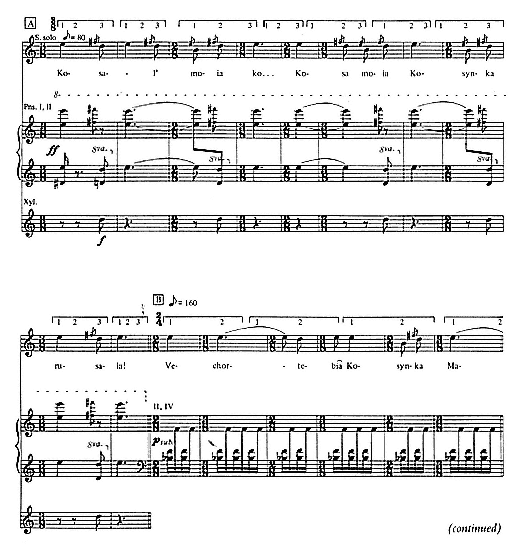
Example 23:
Les Noces
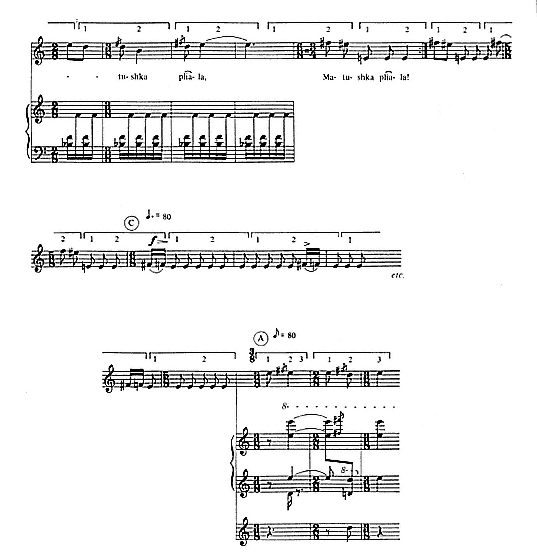
Example 23
(continued)
Similar inferences may be drawn from the material of Block B. Here, however, the periodicity is duple rather than triple. Moreover, the foreground irregularity comes by way of a subtactus unit, while in Block A it surfaces by way of the tactus. In other words, while Stravinsky doubles the marking for the eighth-note from 80 to 160 at Block B, the listener is far more apt to hold on to the marking of 80, which becomes the marking for the
quarter-note (as tactus). And with the eighth-note relegated to a subtactus unit (and given, as well, the brevity of Block B in relation to Block A), the


With Block C the dotted quarter-note is given the marking of 80, which in turn stipulates a triple division of the retained pulse. And while the stressed F


















Example 24 re-bars the material of Blocks A and B in accord with the



Example 24:
Les Noces (re-barred)